We are so accustomed to the flow of information that we feel uncertain without it. Therefore, the city, equipping more or less house, the first thing appears TV. And so that in the countryside he worked, a television antenna for the cottage is necessary. It is selected depending on the location of the nearest repeater - TVsvleviva and the type of television signal, which will be "catching".
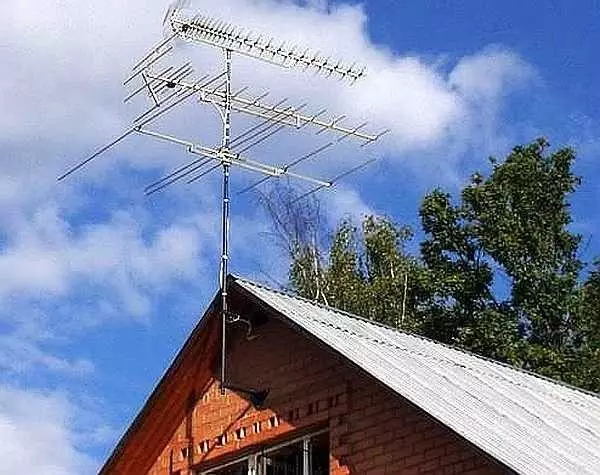
Little can be seen cottage without antennas
Today there are several types of signals, and, accordingly, as many types of antennas:
- Essential analogue television - the signal is encoded and transmitted in a specific wave range: DMV (decimeter waves), MV (meter). Essential television antennas can most often be seen on dachas. Though with them and quite a lot of questions arise, they are quite a bit. If the cottage is seasonal, then you spend most of the time on the site, and see the TV or in bad weather, or in the evening when there is no possibility. For several hours of viewing, the equipment is expensive not everyone wants, but several channels that can "catch" such devices are quite enough.
- Satellite television. The transmission of the signal comes from the satellite, the quality is usually good, the number of channels is calculated by hundreds. But, the antennas-plates cost a lot. For a good reception in the countryside, they must be large sizes - at least 90 cm, which also affects the price. In addition, satellite broadcasting is paid, and payment is taken for the year. There are inexpensive packages, they make sense to buy, if even in winter you appear at the dacha. But in the case of satellite antennas, there is a question of their conservation. If someone from the neighbors live constantly or there is a good (!) Protection, the equipment can survive. If not - it is better to dismantle it, and this is not the easiest job.
- Digital television. In the Russian Federation, a program was adopted, according to which by the end of 2019, the whole territory should be covered by digital television. If there is a tower broadcasting a TV signal in digital format near your cottage, you can consider you lucky, with the help of an ordinary Essential DMW antenna and a television console (SET TOP Box) with a DVB-T2 tuner, you can take in good quality 20 channels. If the TV has a new generation that supports this format, then you do not need consoles, a rather correctly correlated antenna.
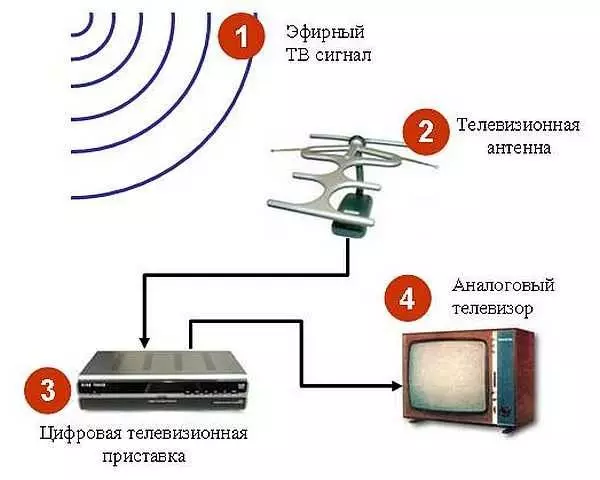
How to make an antenna for DVB T2 for cottage (for receiving a digital TV channel)
Essential Telantenna: What to choose for giving
To say exactly what antenna to put on your dacha can only with respect to each specific case. When choosing, it is taken into account:- Location - plain, hill, lowland;
- the presence or absence of forests and large trees near the house;
- Distance to the nearest repeater.
The main value is the distance to the broadcaster and what. The height you can raise the antenna. Sometimes each meter matters.
Bedroom or outdoor
Room antennas can only be set if the repeater is in your direct visibility. If a telephone is visible from your country site, you can try. In order not to spend in vain money, you can make the most uncomplicated antenna with your own hands: take a piece of wire, connect it to the appropriate TV connector, and be like this "antenna" on the room, climb higher to the ceiling, closer to the window, etc. If at least some signals are caught, you can try to make a room antenna or buy.
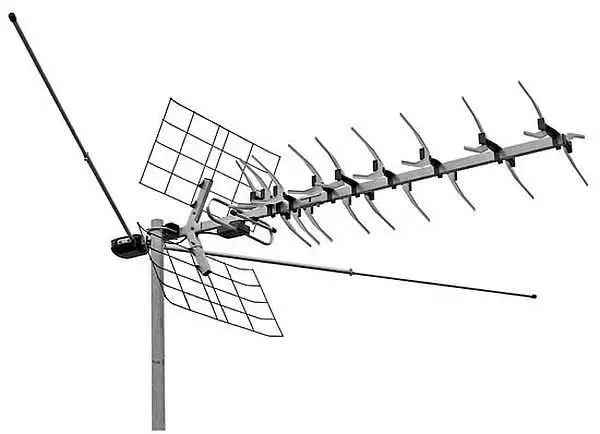
Outdoor antennas "Catch" in tens of kilometers from repeaters
If there are no signs of a clear signal with all movements, you need an outdoor antenna, but for the zone of confident reception (with less amplification). For all other cases, when the distance to the tower is tens of kilometers, it is uniquely external antenna.
Broadband or narrow-controlled
Since the essential television is broadcast in two ranges - decimeter and meter, then there are antennas for these ranges. If the receiver "catches" the signal is only in one range, they are called narrowband. They are only for DMW or only for MV frequencies.There are still broadband (called more allocated) - their design is designed to be able to normally receive a signal at all frequencies. They are usually more cumbersome and heavy, have a long bar. But with this, there is a broadband television antenna for giving can "catch" more channels. Because most often buy them.
Active or passive
More attention should be paid to this, the active or passive antenna is better to put. The active is called a device with an amplifier built into the case. Passive is only the glands to which the amplifier needs to be purchased separately.
Active, with a built-in amplifier, receivers are cheaper, take more channels, but they have a significant minus: the amplifier boards are often broken. Any more or less serious thunderstorm, and channels that were previously accepted clearly, begin the "snow" or in general disappear. Help the trouble can replace the board. To do this, you need to climb on the roof, remove the antenna, change the board, install it and adjust it again. This procedure may be repeated after each thunderstorm.
Even if the thunderstorms did not affect the performance of your country antenna, anyway after a year and a half the number of well-received channels decreases. Quality becomes gradually worse, and sooner or later, you notice that it is no longer possible. The reason is the oxidation of contacts and elements on the board. Receivers on the antenna are far from sealed and dust falls inside, moisture, destroying contacts and tracks. Therefore, the average life of the active antenna is about a year. Not a thunderstorm, so the oxidation will achieve it.
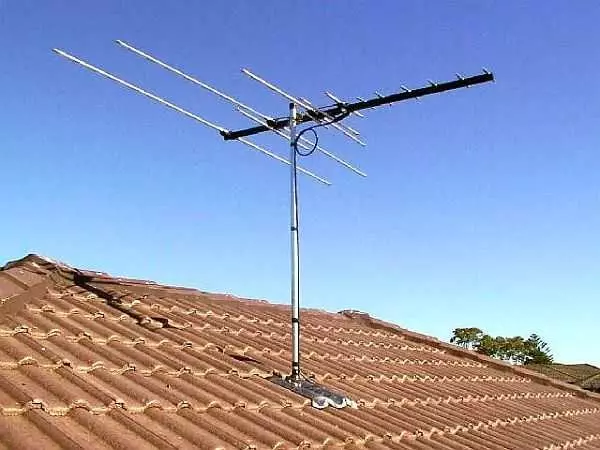
Best Antenna for Dacha: Inactive with a separate amplifier
With a thunderstorm, the case does not help with anything, and the oxidation can be slowed down to significantly, if immediately after buying from both sides, pour the board with silicone. It will save the contacts and elements from oxidation. Nobody will repair it anyway if the fee "flew", buy a new one and put it in place. That's all the repair. It is also useful to take a cable connection location. Here, too, due to oxidation there are large losses of the signal.
Passive antennas with separate amplifiers are good because the "piece of iron" is installed above the roof, and the amplifier is in the attic. Replacing the fee in the attic causes much less problems than on the roof. Especially in winter. They "catch" fewer channels, but the picture is "cleaner".
There is another plus: individual amplifiers have two adjustments - separately on DMV range and mV. This is useful since sometimes some signals go with a much greater level and they are "clogged" weaker. Then the sound overlap and / or the image is observed, in some cases, if some signal is very strong, generally goes with solid snow. Setting the sensitivity of the ranges can be saved. So passive antennas with separate amplifiers for summer cottages are the best choice.
In the TVs "Samsung" and "El Ji" generally there is a "weak signal" function. In this case, the amplifier cannot be needed at all. Put the passive antenna in the country, turn on the mode, and customize the channels. It should show quite well at least 5-6 channels.
Ground or not
Another problem that requires a solution - should the television antenna for the cottage should be grounded. On the one hand, it is often the highest point. On the other hand, if it is grounded, it will catch any discharge of lightning, which will be nearby. Accordingly, every time you have to change the fee, as it fails.
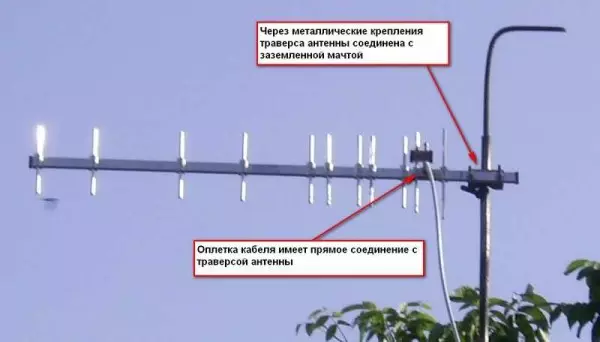
If you decide the antenna, it is still ground, attach a cable braid to a metal bar, and ground ground
For this reason, "antennters" insist on the fact that they do not need to ground. Especially if the device is below the power supply wires. Lightning then will hit the highest grounded point. The main thing is that it is not your antenna.
What antennas are better
As usual, in addition to the type of equipment, you have to choose the manufacturer. And this, perhaps, is no easier. Recommendations can help. On forums of popular manufacturers, several:- Lokus (locus). Russian-made antennas. A wide range, low prices (from 480 rubles to 1.7 thousand rubles). There are both active - with a built-in amplifier and passive.
- Harpoon. Also an antenna of Russian production. Takes in zones of DMB and MV range. Release only in a passive form, designed to install in the zones of uncertain reception. Retail price - harpoon-0416 - 1500 rubles, harpoon-1028 - 2300 rubles.
- Delta antennas manufactured by CJSC NPP Ost. The range is very wide here. There are both narrow-controlled for MV or only for DMW ranges and broadband. Moreover, the dmv antennas can be used to receive digital television DVB-T2 signal. Many models are equipped with an F-connector - a device through which the cable is connected: when installing it does not need to be disassembled to connect it. Purified from insulation conductor insert into the socket. Everything. Cable connected.
- Goldmaster (Goldmaster). There are few reviews, but according to the existing, takes reliably even in the zone of uncertain reception. Even during the rain, the signal quality almost does not fall. The picture still remains a clear, without "snow".
All other manufacturers do not use much popular.
For inactive antennas, amplifiers are needed. Here also have its own preferences:
- LHA house amplifier;
- Terra (Terra);
- Powerful amplifiers with low noise breeze, Alcad (alkad).
Install antenna
Before starting all the work, all the coins, wrenches, antenna connections to miss "Movil" or "Lithol", with something similar by properties. If the active antenna is selected, the board is better to sealed with silicone. After such processing, the antenna will not last year, but much longer.
About which cable is used to connect. It is better not to try to save: there will be too big losses. Therefore, take branded SAT 50 or SAT 703. From the quality of the cable and the quality of the "Picture" connections, it depends not less than from the reception.
Television antenna for the cottage: where and how to install
The installation location is selected taking into account where you will need to direct the antenna. If the roof and wind loads allow you to fasten it on the roof. In order to raise the receiver above, the antenna is fixed on the mast. There are special clamps for this.
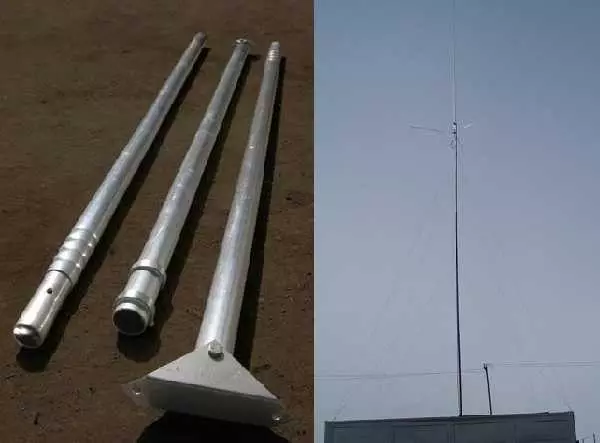
In some cases, you have to raise an antenna as above - in lowlands or if the trees overlap the reception. Then use telescopic rods
Mastows have metal teams, there are telescopic - folding. This view is more convenient, especially if the antenna with the receiver - periodically will need to change the fee, and dismantle the mast every time - the pleasure is still. Telescopic masts can be omitted by spilling a locking ring. The antenna attacked on the top of the tip along with the top of the rod.
If you do not need to raise, you can use a wooden timber or an open trunk of a young pine. This is a completely dacha option. You can use the steel pipe is not very large diameter or corner. Sea options. The chosen support must be fixed. Fastening methods are presented in the figure.
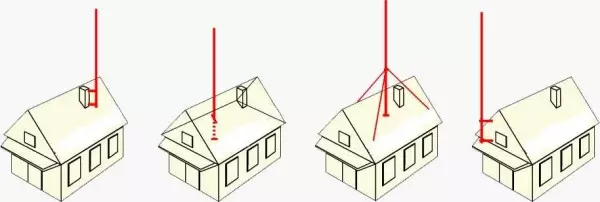
How to install a mast for antenna
Most often occurs the attachment of the antenna on the fronton. It is easier to be implemented, but only if the finish or material of the wall allows. This is not fixed on the walls covered with siding, and on the walls of aerated concrete - too complicated. Then the option is to secure the bar to the pipe, to the rafters, or stretch marks to the roofing material.
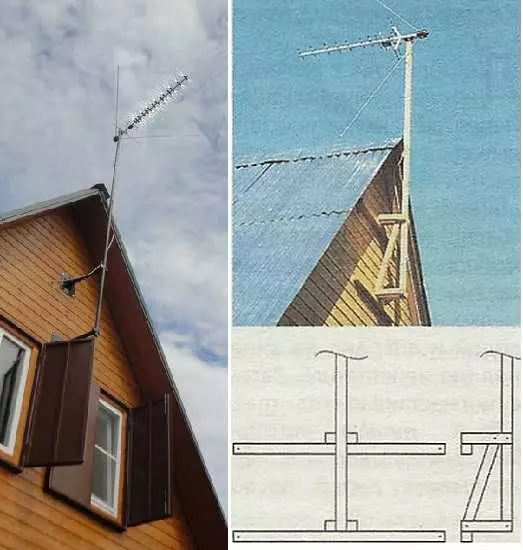
Methods for fastening antenna to the fronton building: from iron and wood
When mounting to the frontton, the distance between the fastener should be at least 1.5 meters. If none of these methods for some reason cannot be implemented, you can try to establish an antenna on a growing near the powerful tree. Attach the antenna will be to the trunk, and cut branches that interfere with the reception. Sometimes it is the best way.
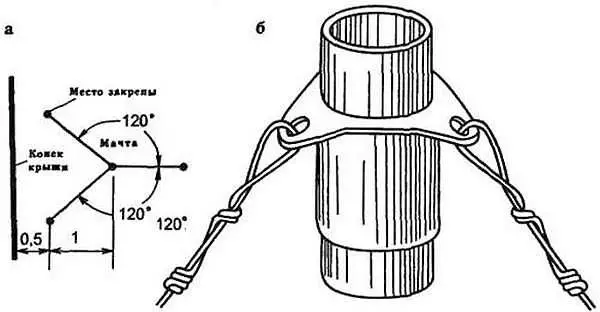
How to fix the bar on stretch marks
Cable mount
When installing an antenna, the cable is lowered down along the bar. It is fixed with clamps every 50-80 cm. After pulling down the cable to the level of the roofing material, it is on the row (so that it does not cut off the snow to the snow) firing to the bracket, with which it is descended from the roof. The bracket is attached over the window near the TV. The cable to the room is set through the hole in the window frame. With the tilt up the hole drill a hole slightly larger diameter than the diameter of the cable. So raindrops will not fall inside the frame. The cable before the frame should be slightly saved - we give freedom to temperature changes.
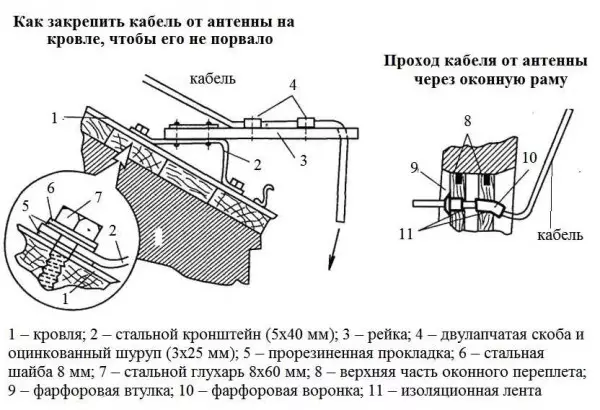
How to install an antenna in the country: fix the cable correctly
If the television antenna for the cottage is inactive, the amplifier is installed on the attic, the cable from the antenna is displayed to it, and from the amplifier to the TV.
One advice: when laying, you need to avoid steep bends. The minimum radius is at least 5 cable diameters. When fixing with brackets, it is not necessary to press it.
How to cut and connect the antenna cables See in the video.
Article on the topic: Wood trim with do-it-yourself: Facing the bedroom
